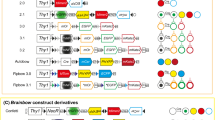Abstract
The specificity of highly differentiated tissues is largely achieved through the action of cell- and stage-restricted transcription factors. The basic events in skeletal muscle development are triggered by a unique family of myogenic basic helix-loop-helix proteins –MyoD, Myf-5, myogenin and MRF-4. Binding sites for these factors are found in the promoter regions of many genes whose expression is restricted to muscle cells, but the tight regulation of gene expression is dependent on the interaction of different factors. In this respect zinc finger proteins seem to play an important role, not only in the establishment of muscle cells but also in the maintenance of muscle function. This review discusses several zinc finger proteins that have been characterized as regulators of muscle development and muscle-specific gene expression.
Similar content being viewed by others
Author information
Authors and Affiliations
Additional information
Received: 15 September 1998 / Accepted: 10 November 1998
Rights and permissions
About this article
Cite this article
Krempler, A., Brenig, B. Zinc finger proteins: watchdogs in muscle development. Mol Gen Genet 261, 209–215 (1999). https://doi.org/10.1007/s004380050959
Issue Date:
DOI: https://doi.org/10.1007/s004380050959




